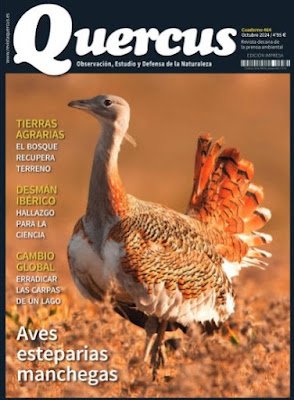Aves esteparias manchegas
Con este título abre la portada del último número de la revista Quercus, que como a ellos les gusta decir es la decana de la prensa ambiental en España. Con un título tan sugerente para un blog como éste, no se puede dejar escapar la ocasión darlo a conocer, de manera que te presento aquí los principales resultados obtenidos en un trabajo de seguimiento de cuatro años. Aunque te remito a que te hagas con la revista original.
De 2019 a 2023 siguieron a avutardas, sisones y gangas (ortegas e ibéricas) en Castilla la Mancha utilizando las metodologías estandarizadas para cada especie. Y sin entrar demasiado en números, observaron que la avutarda se mantuvo estable (7214 ejemplares de media) aunque con cierta tendencia a la baja.
Los sisones, por su parte, se censan en invierno y en primavera, con métodos diferentes. Observaron una disminución en los meses invernales con respecto a censos anteriores, y en época reproductora el descenso fue aún más marcado en los últimos veinte años (nada menos que de un 57% respecto al año 2005).
Las gangas también se han contado en invierno y primavera. Encontraron que la ganga ibérica se mantiene constante desde el último censo de 2005 (incluso se ha incrementado), y sin embargo la ganga ortega (mucho más escasa) ha sufrido un importante declive en la región, puesto de manifiesto ya en el último censo nacional.
 |
| Portada revista Quercus, octubre 2024 |
ENGLISH VERSION:
This is the title of the cover of the latest issue of Quercus magazine, which, as they like to say, is the dean of the environmental press in Spain. With such a suggestive title for a blog like this one, I could not miss the opportunity to make it known, so I present here the main results obtained in a four-year follow-up work. Although I refer you to the original magazine.
From 2019 to 2023 they followed Great Bustards, Little Bustards and Sandgrouses in Castilla la Mancha using the standardised methodologies for each species. Without going too much into numbers, they observed that the Great Bustard remained stable (7214 individuals on average) although with a downward trend.
Little Bustards, on the other hand, are censused in winter and spring, using different methods. They observed a decrease in the winter months with respect to previous censuses, and in the breeding season the decrease was even more marked in the last twenty years (no less than 57% with respect to 2005).
Bargains were also counted in winter and spring. They found that the Pin-tailed Sandgrouse has remained constant since the last census in 2005 (it has even increased), while the Black-headed Sandgrouse (much scarcer) has suffered a significant decline in the region, which was already evident in the last national census.
Comentarios
Publicar un comentario